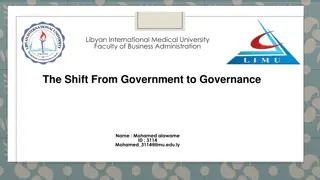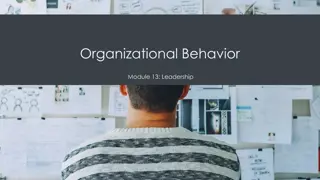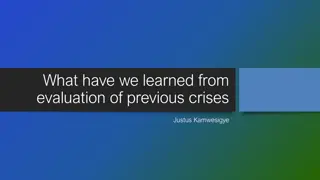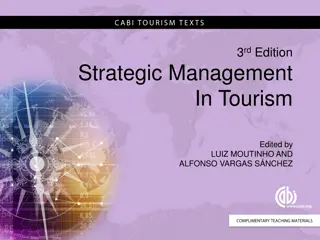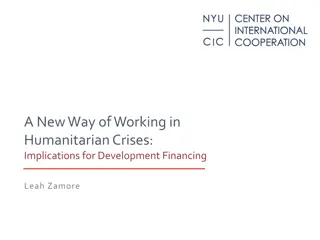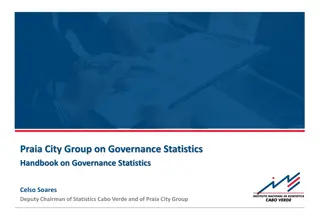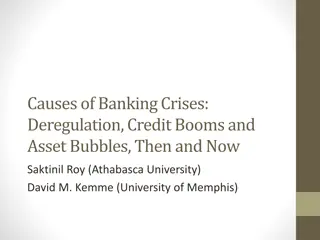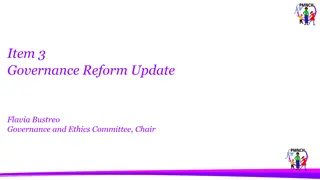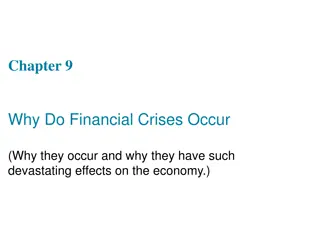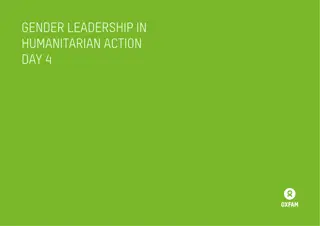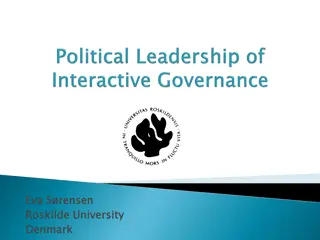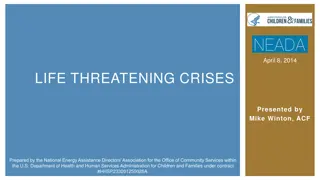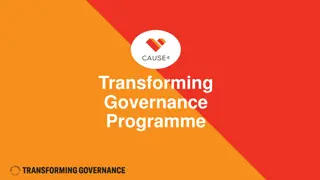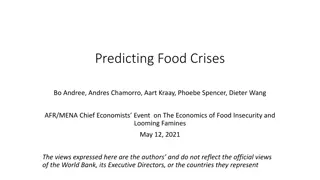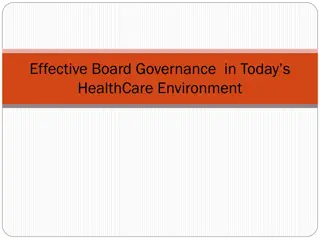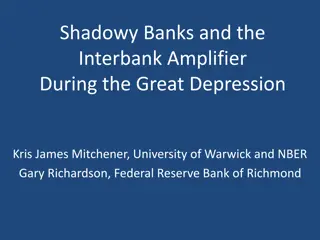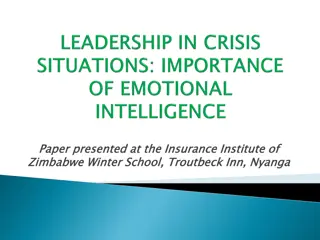Leadership and Governance in Health Crises: A Comprehensive Guide
This manual provides insight into effective leadership strategies during bioattacks and epidemics to maintain public trust. It outlines the challenges faced by officials, offers strategic goals for crisis response, and emphasizes the importance of collaboration with the public for successful outcomes.
Download Presentation

Please find below an Image/Link to download the presentation.
The content on the website is provided AS IS for your information and personal use only. It may not be sold, licensed, or shared on other websites without obtaining consent from the author. Download presentation by click this link. If you encounter any issues during the download, it is possible that the publisher has removed the file from their server.
E N D
Presentation Transcript
How to Lead During Bioattacks with the Public s Trust and Help A Manual for Mayors, Governors, and Top Health Officials UPMC CENTER FOR BIOSECURITY
Purpose Anticipate and Avert Governing Trouble Spots that Arise during Epidemics Set forth strategic goals that distinguish effective, compassionate leadership in epidemics Illustrate circumstances posed by bioattacks that further complicate response to the health crisis Identify dilemmas of governing that commonly arise during epidemics natural or deliberate Recommend principles and actions for averting and/or remedying such predicaments Presentation Overview
Working Group on Governance Dilemmas in Bioterrorism Response Convened by UPMC Biosecurity Center staff, Feb 2003 to Feb 2004 Thirty members including seasoned political and public health decision-makers Consensus statement Biosecurity & Bioterrorism 2004;2(1):25-40 Experience, professional judgment & evidence obtained by literature review Presentation Overview
What defines leadership during an epidemic or biological attack?
Dynamic Collaboration with the Public Essential Means to Strategic Aims Swifter resolution of immediate health crisis Enhanced social and economic resilience of affected communities Continuity of fundamental democratic values and processes Successful Leadership Strategic Goals
Strategic Goals Limit death and suffering through proper preventive, curative, and supportive care Defend civil liberties by using least restrictive interventions to control spread of disease Preserve economic stability, managing impact on victims and hard-hit locales Discourage scapegoating and stigmatization Bolster ability of individuals and groups to rebound from traumatic events Successful Leadership Strategic Goals
Why do biological attacks present special challenges and high-stakes decisions for leaders?
Epidemics Are Complex Phenomena due to Unfolding Biology and Competing Social Aims Troubling to consider leaders and the public may deny problem or intervene too quickly without regard to negative effects. People need to make sense of random and terrifying events, but epidemics elude quick and easy explanation. Mysterious diseases can trigger impulse to isolate oneself and blame others, or to care for victims without regard to one s own safety. Bioattacks Unique Challenges
Modern Conditions Disperse Impacts More Quickly, Make Some People More Vulnerable Global, round-the-clock news reports cause fear and dread and in places far from immediate harm. Today s transportation moves people quickly across vast distances, potentially accelerating spread of disease. Epidemics have broad, indirect financial impacts due to close ties among global, national, and local economies. Poverty, lack of insurance, and distrust of healthcare system make those most vulnerable during outbreaks the least able to protect themselves. Personnel shortages and lean budgets limit response capabilities of U.S. hospitals and health agencies. Bioattacks Unique Challenges
Case Study SARS 2003 >4,000 cases (1/2 total global count) traceable to chance encounter by handful of international travelers with virus at four-star Hong Kong hotel; among the guests was an infected doctor who had treated patients in Guangdong Province, where the outbreak first emerged. When the global SARS outbreak peaked, some New Yorkers transposed news reports on conditions in hard-hit cities like Hong Kong to their hometown, where impact was negligible. Bioattacks Unique Challenges
Calculated Attack Further Magnifies the Consequences of an Epidemic Attacker s motivations and tactics attacks on multiple cities or over a prolonged period heighten an epidemic s uncertainties. Scapegoating will be more severe than in natural outbreaks as people demand to know, Who did this?! If a disease is weaponized or infects people through an unusual route (such as the mail), it may be harder to detect and treat. Bioattacks Unique Challenges
Case Study Anthrax 2001 Frustration and confusion arose from lack of immediate answers to basic, factual questions. Who did this? How many letters were involved? Health authorities and clinicians had to make critical decisions based on partial science: What is best treatment? Who should receive antibiotics and for how long? Which mailrooms should be closed and surveyed? Apparent gaps in the government s response fostered more uncertainty: Were officials withholding information about the attack? Was treatment for postal workers and Capitol Hill employees really different, and why? Bioattacks Unique Challenges
What leadership dilemmas may arise in a deliberate epidemic, and how might they be averted?
Conflicts of Interest, Priority, and Purpose that Commonly Emerge during Epidemics Balancing imperatives of disease control with: Individual liberty Economic stability Protection against victim stigmatization Epidemics Recurring Dilemmas
Stopping Disease that Spreads Person-to- Person while Upholding Individual Freedoms Make bioterrorism plans public before crisis occurs; a well-informed population is more likely to follow advice. Sketch out the big picture ; make concrete the fact that personal actions can affect the safety of others. Provide goods and services that help people comply with health orders. Use disease controls that respect autonomy and self- determination: Public cooperation limits illness and death; resistance does not. Restrict civil liberties, if necessary, only in a transparent and equitable way. Epidemics Recurring Dilemmas
Case Study Smallpox 1894 Facing a citywide outbreak, Milwaukee health authorities forcibly removed infected individuals to isolation hospitals, selectively using this technique among impoverished immigrants and not the well-off. Perceived to be discriminatory and authoritarian, these measures caused month-long riots and ultimately abetted the spread of smallpox. Outbreak Impact: 1,079 cases, 244 deaths Epidemics Recurring Dilemmas
Case Study Smallpox 1947 NYC officials effectively quelled outbreak by implementing a voluntary mass vaccination campaign that was universally applied, carrying out an elaborate public relations campaign, and involving grassroots organizations. Outbreak impact: 12 cases, 2 deaths Epidemics Recurring Dilemmas
Protecting the Economy while Using Disease Controls that Disrupt Commerce Be mindful of the goal of long-term financial recovery when controlling disease; do not react based solely on the desire to avert short-term economic loss. Recognize public trust as precious capital that grows the economy if people see their health as your top priority, confidence in your efforts to safeguard the economy will follow. Account for the less visible and more scattered monetary impacts when making epidemic control decisions (e.g., costs of victims healthcare, economic toll of stigma). Epidemics Recurring Dilemmas
Case Study Tylenol 1982 7 Chicago-area residents died after taking Extra-Strength Tylenol capsules laced with cyanide. J&J executives halted manufacture, withdrew product worldwide, and offered customers refund or replacement. $100 million in inventory was destroyed; market share dropped 87%; experts predicted the brand s demise. J&J reintroduced Tylenol products with tamper-resistant packaging, with robust advertising campaign. Responding to the company s civic-minded behavior, consumer confidence rebounded, quickly returning market share to pre-crisis levels. Epidemics Recurring Dilemmas
Restoring Social Bonds when People Feel at the Mercy of a Mysterious Disease or Attacker Express empathy for people s fears about getting sick from others; help people gauge personal risk accurately. Explain to community-at-large the social costs of avoiding people out of fear, rather than out of actual danger. Give frequent updates on the criminal investigation; counsel people not to lash out against others. Spotlight community projects aimed at bringing people together across social divisions sensitized by the crisis. Direct law enforcement to deal appropriately with hate crimes in the event prevention fails. Coordinate humanitarian relief effort, with extra focus on assisting the most vulnerable. Epidemics Recurring Dilemmas
Case Study Anthrax 2001 Employees of American Media, Inc., the site of the first inhalational anthrax case, were doubly victimized. Physically threatened by potential exposure to anthrax, they sometimes found themselves shunned by other community members. Long-time physicians refused to care for them; schools turned away their children; and those moonlighting as housekeepers were not allowed into homes to clean. Epidemics Recurring Dilemmas
What situations splinter the social trust necessary to cope with health crises, and how might they be defused?
Alienation between Leaders and Public, and among Community Members Themselves Breaches in social trust are a common predicament during outbreaks and are likely to arise during a bioattack. Often propelled by: Pre-existing social and economic fault lines Preconceived notions about the government, the public, and the media Social Trust Building Reserves
Unproductive Fear, Denial, or Skepticism by the Public when Leaders Give Crisis Updates Share what you know. Creative coping is the norm; panic is the exception. Hold press briefings early and often to reach the public. Confirm that health agencies and medical facilities can handle onslaught of questions from concerned people. Convey facts clearly and quickly so that people have peace of mind or so that they seek out care, if need be. View rumors as a normal sign of the need to make sense of vague or disturbing events. Refine your outreach efforts; the current ones may not be working. Social Trust Building Reserves
Earning public confidence in leaders plans for effective use of scarce resources Account for income disparities in planning; anticipate the need for free or low-cost prevention and treatment. Make planning transparent so that the public sees that access to life-saving resources is based on medical need and not on wealth or favored status. Be open about eligibility criteria for goods and services, especially when tough choices arise unexpectedly. Show thorough preparations to protect vulnerable populations like children and the frail elderly, thus bolstering everyone s sense of security. Social Trust Building Reserves
Case Study Healthcare Access Given routine differentials healthcare access and a prevalent belief that inequity will prevail during a bioattack, leaders are in the unfortunate position of having to prove otherwise. One of every seven Americans lacks health insurance, with minorities overrepresented. 72% of respondents to a Dec. 2002 national poll said they believed that if it were not possible to vaccinate everyone quickly during a smallpox outbreak in their community, wealthy and influential people would get the vaccine first. Social Trust Building Reserves
Maintaining Credibility when Leaders Have to Decide before All the Facts Are in Advise the community at the outset if crisis conditions are evolving or could be prolonged. Offer more detail rather than less, even when the unknowns outnumber what is known. Resist the urge to reassure for reassurance sake alone. Be frank about any uncertainty regarding facts ; describe plans to fill in knowledge gaps. Vary your means of reaching the public. Mix high-tech outreach with contact through grassroots leaders. Social Trust Building Reserves
Case Study Anthrax 2001 Secretary of Health s definitive reassurances that Bob Stevens s inhalational anthrax was an isolated case and that there is no terrorism came before all the facts were in. Created the impression that the government was not forthcoming about the extent of the problem, especially when more cases of infection and anthrax-laden letters turned up. Social Trust Building Reserves
Leadership Conscious Pursuit of Shared Responsibility for the Public s Health Approach the public as a capable ally Keep planning and response transparent Prioritize voluntary compliance among the many above coercion of the few Advance equity in access to emergency resources Share difficult decisions when they arise Call for solidarity and compassion while shielding and aiding the ostracized Conclusion
Veteran Political and Public Health Leaders Georges Benjamin, MD, FACP, Exec Director, American Public Health Association; Maryland s Commissioner of Health during 01 anthrax attacks William Bicknell, MD, MPH, Professor and Chairman Emeritus of International Health at Boston University, School of Public Health; former Commissioner of Health for Massachusetts Neal L. Cohen, MD, Executive Director, AMDeC Center on Bioterrorism; former Commissioner of Health for New York City during 99 West Nile Virus outbreak, 01 World Trade Center bombing, and 01 anthrax attacks Working Group Aaron Greenfield, JD, Executive Director, Maryland Business Council; former Special City Solicitor & Homeland Security Advisor, Baltimore City Mayor s Office Margaret A. Hamburg, MD, Vice President, Biological Programs, Nuclear Threat Initiative; former Assistant Secretary for Planning & Evaluation, Department of Health and Human Services Jean Malecki, MD, MPH, FACPM, Director, Palm Beach County Health Department; led investigation team of first inhalational anthrax case in 2001 Tara O'Toole, MD, MPH, Director, UPMC Center for Biosecurity; former Director, Johns Hopkins Civilian Biodefense Center; former Assistant Secretary of Energy for Environment, Safety and Health
Medical, Public Health, and Disaster Experts Kenneth D. Bloem, MPH, former top executive at Georgetown, Stanford, Chicago, and Boston University Medical Centers Brian W. Flynn, EdD, Associate Director, Center for the Study of Traumatic Stress, Uniformed Services University; former Rear Admiral/Assistant Surgeon General, U.S. Public Health Service Thomas V. Inglesby, MD, Deputy Director, UPMC Center for Biosecurity; former Deputy Director, Johns Hopkins Civilian Biodefense Center; Infectious Disease Clinician, Johns Hopkins Hospital Working Group Linda Morris, BSN, RN, Director, Community Health & Youth, Greater Kansas City American Red Cross (GKC-ARC); former Community Health Nurse Manager, GKC-ARC Ann E. Norwood, MD, COL MC, USA, Associate Professor & Associate Chair, Department of Psychiatry, Uniformed Services University Monica Schoch-Spana, PhD, Chair; Senior Fellow, UPMC Center for Biosecurity; former Senior Fellow, Johns Hopkins Civilian Biodefense Center Kathleen Tierney, PhD, Director, Natural Hazards Research and Applications Center; Professor of Sociology, University of Colorado at Boulder
Community Leaders and Special Population Advocates Naomi Baden, JD, MS, Facilitator, mediator, & negotiator specializing in inter- and intra-organizational decision-making processes Marion J. Balsam, MD, FAAP, Diplomate, American Board of Pediatrics; Member, American Academy of Pediatrics Task Force on Terrorism; retired Rear Admiral of Medical Corps of the U.S. Navy Emira Habiby-Browne, MA, Founder & Executive Director, Arab-American Family Support Center, New York City Working Group Robert G. Kaplan, Founding Director, Commission of Intergroup Relations & Community Concerns at the Jewish Community Relations Council of NY; Public Health/Faith Based Community Institute of CDC and Emory Univ. Myrna Lewis, PhD, Assistant Clinical Professor, Community & Preventive Medicine, NYC Mount Sinai School of Medicine; United Nations NGO Committees on Aging and Women; NYC Mental Health Disaster Team Onora Lien, Research Analyst, UPMC Center for Biosecurity; Doctoral Candidate in Sociology, Johns Hopkins University Shirley G. Mitchell, PhD, President, Board of Directors, Phyllis Wheatley YWCA, Washington, DC
News Media, Public Affairs, and Risk Communications Experts Thom Berry, Director, Media Relations, South Carolina Dept of Health and Environmental Control; Pres., National Public Health Information Coalition John Burke, MA, JD, President, Strategic Communications Inc.; Advisor to clients including Union Carbide, Pfizer, Merck, and Johnson & Johnson Joan Deppa, PhD, Associate Professor, S.I. Newhouse School of Communications, Syracuse University; former UPI editor & reporter Working Group Darren Irby, Vice President of External Affairs, American Red Cross Richard Knox, Health & Science Correspondent, National Public Radio Sandra Mullin, MSW, Director of Communications for NYC Health Department during 99 West Nile Virus outbreak, 01 World Trade Center attacks, 01 anthrax attacks, and 03 SARS outbreak Barbara Reynolds, MA, Crisis & Emergency Risk Communication Specialist, CDC; managed public communications during 01 anthrax attacks Peter Sandman, PhD, Risk Communications Specialist; advisor to NYC health department and CDC on bioterrorism, preparedness, and communication Mary E. Walsh, National Security Producer, CBS News, assigned to Pentagon
Support Award MIPT-2002J-A-019 from the Oklahoma City Memorial Institute for the Prevention of Terrorism (MIPT) and the Office for Domestic Preparedness, Department of Homeland Security, and Award #2000- 10-7 from The Alfred P. Sloan Foundation. Disclaimer Points of view in this presentation are those of the working group and do not necessarily represent the official position of MIPT, the U.S. Department of Homeland Security, or the Sloan Foundation.
Project Team Monica Schoch-Spana, Principal Investigator Bruce Campbell, Financial Administrator Molly D Esopo, Production Coordinator Working Group Jackie Fox, Senior Science Writer Tim Holmes, Web Design Specialist Onora Lien, Research Analyst Scott Sugiuchi, Graphic Designer
This presentation, additional materials, and resources are available online at: www.upmc-biosecurity.org/pages/resources/leadership.html




